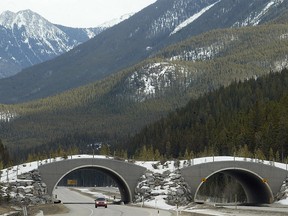Yellowstone to Yukon Conservation Initiative, which advocates to keep wildlife safe near roadways, welcomed the projects

Two new wildlife crossings are being planned for a stretch of Highway 1A between Exshaw and Canmore.
Yellowstone to Yukon Conservation Initiative (Y2Y), which advocates to keep wildlife safe near roadways, welcomed the projects. Landscape connectivity specialist Tim Johnson said the projects exceeded expectations.
“We did hear about the wildlife fencing through the Canmore area that was announced earlier this year by the province, but all the additional pieces on the 1A were great, positive news to hear,” he said.
The government website includes a map of animal-vehicle collision mitigation projects across the province, including a third wildlife crossing planned between Cochrane and Calgary and ongoing construction of the Bow Valley Gap wildlife overpass on the Trans-Canada Highway.
Plans for the proposed Highway 1A overpass and underpass, as described on the website, are to retrofit crossings to existing structures and have about 22 kilometres of wildlife exclusion fencing spanning from the Trans-Canada off-ramp where Highway 1A transitions to Bow Valley Trail, and where the 1A meets Highway 1X.
The underpass would use existing drainage to retrofit a bridge connecting the Fairholme Range in the north to habitat in the Bow Flats Natural Area and around the Bow River in the south.
“Those are often really effective projects because they’re not quite as expensive. It’s taking advantage of the terrain and using an existing watercourse and basically modifying it to be more amenable to wildlife passage,” said Johnson.
The overpass further east will take advantage of a cliff’s edge next to Highway 1A, or as Johnson described it, “a sort of natural entryway to a bridge over the road,” toward Gap Lake.
Dozens of ‘large-bodied wildlife’ have been killed in vehicle collisions
Wildlife common to both sites include deer and elk, especially closer to Canmore, and bighorn sheep.
“The Bow Valley is one of the most developed places in North America, if not the world, where you still have a fairly large suite of medium- to large-size mammals,” said Johnson.
Over the past five years, 62 “large-bodied wildlife” have been struck and killed in vehicle collisions along the highway between Canmore and Highway 1X, government data show.
Mitigation strategies such as overpasses, underpasses, exclusion fencing, enhancing existing bridges to support wildlife passage and animal detection systems have been shown to reduce collisions with wildlife by up to 80 per cent on provincial highways.
The Bow Valley is considered one of the four most important east-west wildlife connectors in the entire 3,200-kilometre length of the Y2Y region and one of two key connectors for wildlife in Alberta.
“Getting animals safely across these roads is definitely a way to mitigate from the ongoing growth of our human presence on the landscape and ensuring that these populations continue to survive as best they can in what is a very busy Bow Valley,” said Johnson.
“It’s prime habitat for a lot of species and it’s also a place where we as humans like to live and recreate.”
Multiple sites recommended for wildlife crossings, fencing
A 2012 study by Miistakis Institute and Western Transportation Institute identified 10 sites recommended for underpasses and associated fencing along a 39-kilometre stretch from the east gate of Banff National Park on the Trans-Canada.
It also recommended an overpass at Bow Valley Gap, east of Lac Des Arcs, where wildlife-vehicle collisions were shown to be the highest in the study area.
The province also announced in February it had hired Dillon Consulting Limited to build 10 kilometres of wildlife exclusion fencing from Banff National Park’s east gate through Canmore, along the Trans-Canada Highway. That project is expected to break ground in 2025.